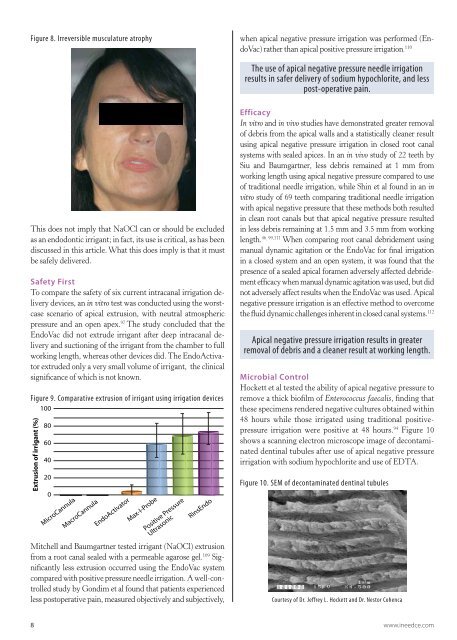Safety and Efficacy Considerations in Endodontic ... - IneedCE.com
Safety and Efficacy Considerations in Endodontic ... - IneedCE.com
Safety and Efficacy Considerations in Endodontic ... - IneedCE.com
Create successful ePaper yourself
Turn your PDF publications into a flip-book with our unique Google optimized e-Paper software.
Figure 8. Irreversible musculature atrophy<br />
This does not imply that NaOCl can or should be excluded<br />
as an endodontic irrigant; <strong>in</strong> fact, its use is critical, as has been<br />
discussed <strong>in</strong> this article. What this does imply is that it must<br />
be safely delivered.<br />
<strong>Safety</strong> First<br />
To <strong>com</strong>pare the safety of six current <strong>in</strong>tracanal irrigation delivery<br />
devices, an <strong>in</strong> vitro test was conducted us<strong>in</strong>g the worstcase<br />
scenario of apical extrusion, with neutral atmospheric<br />
pressure <strong>and</strong> an open apex. 97 The study concluded that the<br />
EndoVac did not extrude irrigant after deep <strong>in</strong>tracanal delivery<br />
<strong>and</strong> suction<strong>in</strong>g of the irrigant from the chamber to full<br />
work<strong>in</strong>g length, whereas other devices did. The EndoActivator<br />
extruded only a very small volume of irrigant, the cl<strong>in</strong>ical<br />
significance of which is not known.<br />
Figure 9. Comparative extrusion of irrigant us<strong>in</strong>g irrigation devices<br />
100<br />
Extrusion of irrigant (%)<br />
80<br />
60<br />
40<br />
20<br />
0<br />
MicroCannula<br />
MacroCannula<br />
EndoActivator<br />
Max-I-Probe<br />
Positive Pressure<br />
Ultrasonic<br />
R<strong>in</strong>sEndo<br />
Mitchell <strong>and</strong> Baumgartner Irrigation tested system irrigant used(NaOCl)<br />
extrusion<br />
from a root canal sealed with a permeable agarose gel. 109 Significantly<br />
less extrusion occurred us<strong>in</strong>g the EndoVac system<br />
<strong>com</strong>pared with positive pressure needle irrigation. A well-controlled<br />
study by Gondim et al found that patients experienced<br />
less postoperative pa<strong>in</strong>, measured objectively <strong>and</strong> subjectively,<br />
when apical negative pressure irrigation was performed (EndoVac)<br />
rather than apical positive pressure irrigation. 110<br />
The use of apical negative pressure needle irrigation<br />
results <strong>in</strong> safer delivery of sodium hypochlorite, <strong>and</strong> less<br />
post-operative pa<strong>in</strong>.<br />
<strong>Efficacy</strong><br />
In vitro <strong>and</strong> <strong>in</strong> vivo studies have demonstrated greater removal<br />
of debris from the apical walls <strong>and</strong> a statistically cleaner result<br />
us<strong>in</strong>g apical negative pressure irrigation <strong>in</strong> closed root canal<br />
systems with sealed apices. In an <strong>in</strong> vivo study of 22 teeth by<br />
Siu <strong>and</strong> Baumgartner, less debris rema<strong>in</strong>ed at 1 mm from<br />
work<strong>in</strong>g length us<strong>in</strong>g apical negative pressure <strong>com</strong>pared to use<br />
of traditional needle irrigation, while Sh<strong>in</strong> et al found <strong>in</strong> an <strong>in</strong><br />
vitro study of 69 teeth <strong>com</strong>par<strong>in</strong>g traditional needle irrigation<br />
with apical negative pressure that these methods both resulted<br />
<strong>in</strong> clean root canals but that apical negative pressure resulted<br />
<strong>in</strong> less debris rema<strong>in</strong><strong>in</strong>g at 1.5 mm <strong>and</strong> 3.5 mm from work<strong>in</strong>g<br />
length. 46, 99,111 When <strong>com</strong>par<strong>in</strong>g root canal debridement us<strong>in</strong>g<br />
manual dynamic agitation or the EndoVac for f<strong>in</strong>al irrigation<br />
<strong>in</strong> a closed system <strong>and</strong> an open system, it was found that the<br />
presence of a sealed apical foramen adversely affected debridement<br />
efficacy when manual dynamic agitation was used, but did<br />
not adversely affect results when the EndoVac was used. Apical<br />
negative pressure irrigation is an effective method to over<strong>com</strong>e<br />
the fluid dynamic challenges <strong>in</strong>herent <strong>in</strong> closed canal systems. 112<br />
Apical negative pressure irrigation results <strong>in</strong> greater<br />
removal of debris <strong>and</strong> a cleaner result at work<strong>in</strong>g length.<br />
Microbial Control<br />
Hockett et al tested the ability of apical negative pressure to<br />
remove a thick biofilm of Enterococcus faecalis, f<strong>in</strong>d<strong>in</strong>g that<br />
these specimens rendered negative cultures obta<strong>in</strong>ed with<strong>in</strong><br />
48 hours while those irrigated us<strong>in</strong>g traditional positivepressure<br />
irrigation were positive at 48 hours. 94 Figure 10<br />
shows a scann<strong>in</strong>g electron microscope image of decontam<strong>in</strong>ated<br />
dent<strong>in</strong>al tubules after use of apical negative pressure<br />
irrigation with sodium hypochlorite <strong>and</strong> use of EDTA.<br />
Figure 10. SEM of decontam<strong>in</strong>ated dent<strong>in</strong>al tubules<br />
Courtesy of Dr. Jeffrey L. Hockett <strong>and</strong> Dr. Nestor Cohenca<br />
8 www.<strong>in</strong>eedce.<strong>com</strong>

















